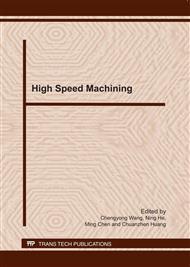p.116
p.122
p.128
p.134
p.139
p.145
p.150
p.154
p.158
Research on Cutting Performances of Tool Rounded Cutting Edge in High Speed Milling Hardened Steel
Abstract:
Simulation models of both dynamic cutting forces and cutting temperatures considering effects of tool rounded cutting edge are established based on analysis of the influences of rounded cutting edge on high speed milling process. Influence law of tool rounded cutting edge radius on force and heat distribution in high speed milling hardened steel has been obtained according to the simulation results and also the simulation results have been verified by experiments. The results indicate that dynamic performances of high speed milling cutter in cutting hardened steel are directly influenced by rounded cutting edge radius, and the cutting forces fluctuated greatly with the variation of rounded cutting edge radius. Variations of rounded cutting edge radius have greater impact on cutting temperatures when the rounded cutting edge radius is less than 40μm. Cutting temperature rise slowly with the increase of rounded cutting edge radius when the rounded cutting edge radiuses are larger than 40μm. Simulation can precisely predict cutting temperatures and cutting forces considering influences of rounded cutting edge radius. Rounded cutting edge radius should be kept around 40~45μm for optimal cutting performances according to its influences on cutting forces and cutting temperatures in high speed milling hardened steel.
Info:
Periodical:
Pages:
139-144
Citation:
Online since:
March 2011
Authors:
Price:
Сopyright:
© 2011 Trans Tech Publications Ltd. All Rights Reserved
Share:
Citation:


